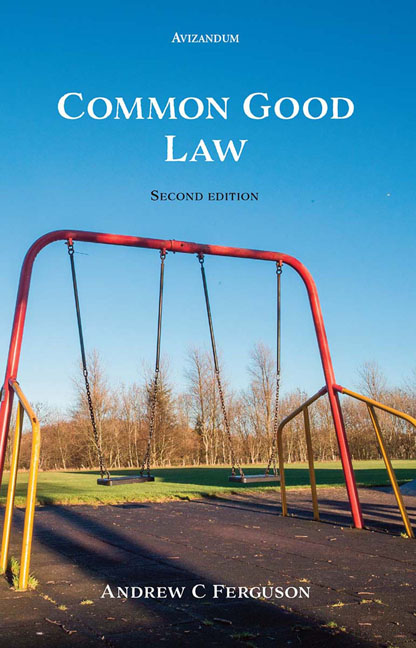Book contents
- Frontmatter
- Contents
- Preface
- Tables of Legislation
- Table of Cases
- 1 Origins and Definitions
- 2 Statutory Framework
- 3 The Administration of the Common Good
- 4 Inalienable Common Good Property
- 5 Classification of Common Good Land
- 6 Appropriation, Alienation and Disposal of Common Good Land
- 7 When Does ‘a Question’ Arise?
- 8 Factors Involved in Allowing Disposal
- 9 Taking a Common Good Case to Court
- 10 Common Good and Community Empowerment
- Appendix I List of Burghs
- Appendix II Disposal, Appropriation and Alienation
- Index
8 - Factors Involved in Allowing Disposal
Published online by Cambridge University Press: 20 October 2020
- Frontmatter
- Contents
- Preface
- Tables of Legislation
- Table of Cases
- 1 Origins and Definitions
- 2 Statutory Framework
- 3 The Administration of the Common Good
- 4 Inalienable Common Good Property
- 5 Classification of Common Good Land
- 6 Appropriation, Alienation and Disposal of Common Good Land
- 7 When Does ‘a Question’ Arise?
- 8 Factors Involved in Allowing Disposal
- 9 Taking a Common Good Case to Court
- 10 Common Good and Community Empowerment
- Appendix I List of Burghs
- Appendix II Disposal, Appropriation and Alienation
- Index
Summary
Pleading own neglect
Assuming an authority has decided that a question arises as to its ability to alienate a piece of ground, and it has decided either to appropriate it or dispose of it, what are the factors involved in the court's decision to allow or disallow such appropriation or disposal? The focus in this chapter will be principally on disposal in the light of the extant case law. There will then be a brief look at alienations falling short of appropriation or disposal in an attempt to determine some pointers as to how a court might deal with such matters nowadays.
So far as disposal under the 1973 Act is concerned, the approach taken by the courts so far is pragmatic, in that it weighs up what would be of most benefit to the community in the former burgh. However, before looking at the benefits, it is necessary to consider two cases which deal with the more fundamental point of why the property is being disposed of in the first place and whether, in fact, the authority's own neglect is the principal or main reason. If so, then a doctrine exists to the effect that a local authority cannot plead its own neglect when seeking authority to dispose of common good property.
For many years, the main authority in this area was the nineteenth-century alienation case of Grahame v Magistrates of Kirkcaldy. This case came up earlier, in 1.1, as representing a classic example of the decline and fall of common good land after the Industrial Revolution in the late eighteenth and nineteenth centuries. Briefly, the facts were that 8 acres had been disponed by royal charter to the magistrates in 1644; in 1754 the land was disponed by the magistrates of the burgh to the then provost under reservation of a right to the inhabitants for drying linen cloths. When the property was disponed back in 1788, that burden remained. Between 1788 and 1804 all but about an acre had been feued off for building as the burgh expanded rapidly.
The remaining acre or so came to be known as the Volunteers’ Green. The burgh ran a sewer through the middle of it and then a road.
- Type
- Chapter
- Information
- Common Good Law , pp. 119 - 131Publisher: Edinburgh University PressPrint publication year: 2020

